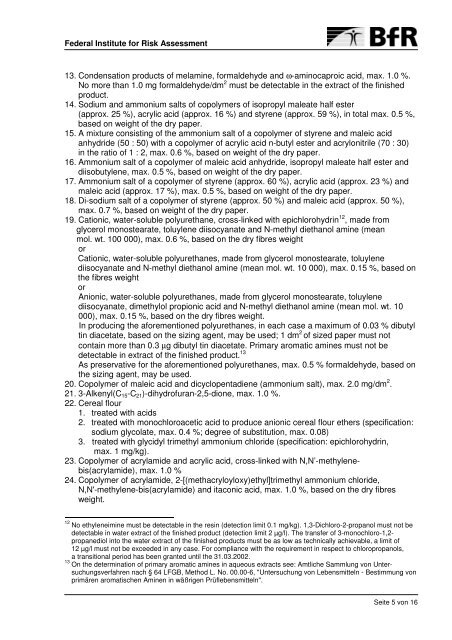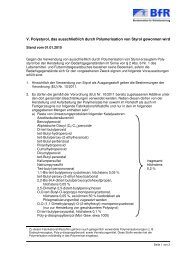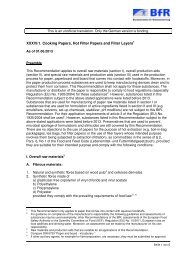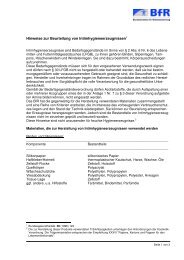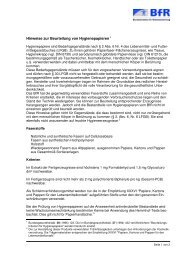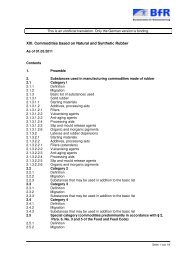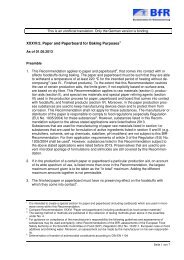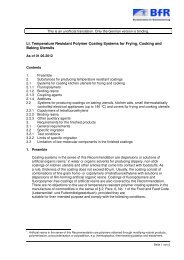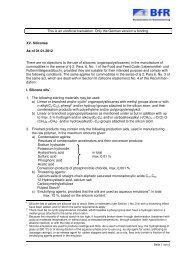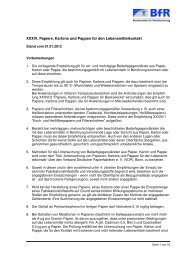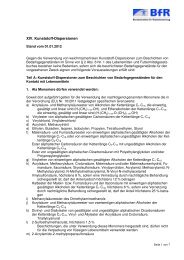XXXVI. Paper and board for food contact
XXXVI. Paper and board for food contact
XXXVI. Paper and board for food contact
Create successful ePaper yourself
Turn your PDF publications into a flip-book with our unique Google optimized e-Paper software.
Federal Institute <strong>for</strong> Risk Assessment<br />
13. Condensation products of melamine, <strong>for</strong>maldehyde <strong>and</strong> ω-aminocaproic acid, max. 1.0 %.<br />
No more than 1.0 mg <strong>for</strong>maldehyde/dm 2 must be detectable in the extract of the finished<br />
product.<br />
14. Sodium <strong>and</strong> ammonium salts of copolymers of isopropyl maleate half ester<br />
(approx. 25 %), acrylic acid (approx. 16 %) <strong>and</strong> styrene (approx. 59 %), in total max. 0.5 %,<br />
based on weight of the dry paper.<br />
15. A mixture consisting of the ammonium salt of a copolymer of styrene <strong>and</strong> maleic acid<br />
anhydride (50 : 50) with a copolymer of acrylic acid n-butyl ester <strong>and</strong> acrylonitrile (70 : 30)<br />
in the ratio of 1 : 2, max. 0.6 %, based on weight of the dry paper.<br />
16. Ammonium salt of a copolymer of maleic acid anhydride, isopropyl maleate half ester <strong>and</strong><br />
diisobutylene, max. 0.5 %, based on weight of the dry paper.<br />
17. Ammonium salt of a copolymer of styrene (approx. 60 %), acrylic acid (approx. 23 %) <strong>and</strong><br />
maleic acid (approx. 17 %), max. 0.5 %, based on weight of the dry paper.<br />
18. Di-sodium salt of a copolymer of styrene (approx. 50 %) <strong>and</strong> maleic acid (approx. 50 %),<br />
max. 0.7 %, based on weight of the dry paper.<br />
19. Cationic, water-soluble polyurethane, cross-linked with epichlorohydrin 12 , made from<br />
glycerol monostearate, toluylene diisocyanate <strong>and</strong> N-methyl diethanol amine (mean<br />
mol. wt. 100 000), max. 0.6 %, based on the dry fibres weight<br />
or<br />
Cationic, water-soluble polyurethanes, made from glycerol monostearate, toluylene<br />
diisocyanate <strong>and</strong> N-methyl diethanol amine (mean mol. wt. 10 000), max. 0.15 %, based on<br />
the fibres weight<br />
or<br />
Anionic, water-soluble polyurethanes, made from glycerol monostearate, toluylene<br />
diisocyanate, dimethylol propionic acid <strong>and</strong> N-methyl diethanol amine (mean mol. wt. 10<br />
000), max. 0.15 %, based on the dry fibres weight.<br />
In producing the a<strong>for</strong>ementioned polyurethanes, in each case a maximum of 0.03 % dibutyl<br />
tin diacetate, based on the sizing agent, may be used; 1 dm 2 of sized paper must not<br />
contain more than 0.3 µg dibutyl tin diacetate. Primary aromatic amines must not be<br />
detectable in extract of the finished product. 13<br />
As preservative <strong>for</strong> the a<strong>for</strong>ementioned polyurethanes, max. 0.5 % <strong>for</strong>maldehyde, based on<br />
the sizing agent, may be used.<br />
20. Copolymer of maleic acid <strong>and</strong> dicyclopentadiene (ammonium salt), max. 2.0 mg/dm 2 .<br />
21. 3-Alkenyl(C15-C21)-dihydrofuran-2,5-dione, max. 1.0 %.<br />
22. Cereal flour<br />
1. treated with acids<br />
2. treated with monochloroacetic acid to produce anionic cereal flour ethers (specification:<br />
sodium glycolate, max. 0.4 %; degree of substitution, max. 0.08)<br />
3. treated with glycidyl trimethyl ammonium chloride (specification: epichlorohydrin,<br />
max. 1 mg/kg).<br />
23. Copolymer of acrylamide <strong>and</strong> acrylic acid, cross-linked with N,N’-methylenebis(acrylamide),<br />
max. 1.0 %<br />
24. Copolymer of acrylamide, 2-[(methacryloyloxy)ethyl]trimethyl ammonium chloride,<br />
N,N'-methylene-bis(acrylamide) <strong>and</strong> itaconic acid, max. 1.0 %, based on the dry fibres<br />
weight.<br />
12 No ethyleneimine must be detectable in the resin (detection limit 0.1 mg/kg). 1,3-Dichloro-2-propanol must not be<br />
detectable in water extract of the finished product (detection limit 2 µg/l). The transfer of 3-monochloro-1,2propanediol<br />
into the water extract of the finished products must be as low as technically achievable, a limit of<br />
12 µg/l must not be exceeded in any case. For compliance with the requirement in respect to chloropropanols,<br />
a transitional period has been granted until the 31.03.2002.<br />
13 On the determination of primary aromatic amines in aqueous extracts see: Amtliche Sammlung von Untersuchungsverfahren<br />
nach § 64 LFGB, Method L. No. 00.00-6, "Untersuchung von Lebensmitteln - Bestimmung von<br />
primären aromatischen Aminen in wäßrigen Prüflebensmitteln".<br />
Seite 5 von 16


